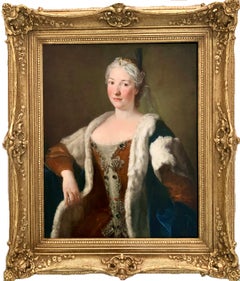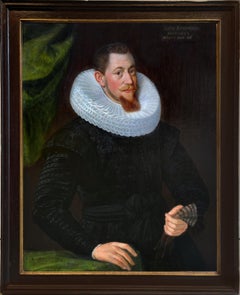Video Loading
Want more images or videos?
Request additional images or videos from the seller
1 of 10
Domenico Puligo16th century Renaissance Florentine painting Domenico Puligo Virgin and Child
$90,313.97List Price
About the Item
- Creator:Domenico Puligo (1492 - 1527)
- Dimensions:Height: 37.41 in (95 cm)Width: 28.35 in (72 cm)
- Medium:
- Movement & Style:
- Period:
- Condition:Ready to hang. Minimal inpainting, mainly along the panel-lines.
- Gallery Location:Aartselaar, BE
- Reference Number:1stDibs: LU1423216385912
About the Seller
5.0
Vetted Professional Seller
Every seller passes strict standards for authenticity and reliability
Established in 2020
1stDibs seller since 2020
376 sales on 1stDibs
Typical response time: 1 hour
Authenticity Guarantee
In the unlikely event there’s an issue with an item’s authenticity, contact us within 1 year for a full refund. DetailsMoney-Back Guarantee
If your item is not as described, is damaged in transit, or does not arrive, contact us within 7 days for a full refund. Details24-Hour Cancellation
You have a 24-hour grace period in which to reconsider your purchase, with no questions asked.Vetted Professional Sellers
Our world-class sellers must adhere to strict standards for service and quality, maintaining the integrity of our listings.Price-Match Guarantee
If you find that a seller listed the same item for a lower price elsewhere, we’ll match it.Trusted Global Delivery
Our best-in-class carrier network provides specialized shipping options worldwide, including custom delivery.You May Also Like
Angelic Cherubs with Classical Figure in Wilderness Finely Painted Preparatory
Located in Cirencester, Gloucestershire
Figure with Cherubim in Wilderness
Italian School, 17th century
oil painting on wood panel
framed 13 x 11 inches
condition: overall for its age very good, though the work is most likely a preparatory...
Category
17th Century Old Masters Figurative Paintings
Materials
Oil, Wood Panel
$3,584
H 13 in W 11 in D 1 in
Large 17th Century Dutch Old Master Oil Painting on Wood Panel Biblical Scene
Located in Cirencester, Gloucestershire
Biblical Figures, Large Gathering around Christ?
Dutch Old Master, early 17th century
oil painting on wood panel, stuck on velvet backing board
velvet board: 27 x 29 inches
board: 25.5 x 26 inches
provenance: private collection, France
condition: good and sound condition, obvious old panel...
Category
Early 17th Century Old Masters Figurative Paintings
Materials
Oil, Wood Panel
Portrait of a Man
Located in New York, NY
Provenance:
with Leo Blumenreich and Julius Böhler, Munich, 1924
Dr. Frederic Goldstein Oppenheimer (1881-1963), San Antonio, Texas; by whom given to:
Abraham M. Adler, New York, until 1985; thence by descent to the present owners
While old inscriptions on the verso of this panel propose its author to be Hans Holbein and the sitter Sir John More—a lawyer, judge, and the father of Sir Thomas More—this fine portrait has long been recognized to be by a Flemish hand. Max Friedländer gave the painting to Bernard van Orley (1487/1491 – 1541) in 1924, but did not include it in the volume dedicated to the artist in his Early Netherlandish Paintings...
Category
16th Century Old Masters Portrait Paintings
Materials
Oil, Panel
Lucretia, by Giacomo Raibolini Francia. Detto il Francia. Oil on panel, framed
Located in New York, NY
Giacomo used to paint with his brother Giulio, identifying their works with the monogram «I I». The strong influence of his father, Francesco, is undeniable in all his works, althoug...
Category
16th Century Old Masters Figurative Paintings
Materials
Oil, Wood Panel
$18,000
Free Shipping
H 25.6 in W 19.3 in D 1.19 in
Christ on the Cold Stone – After Jan Gossaert (Mabuse)
Located in Stockholm, SE
This striking devotional image, painted by a follower of Jan Gossaert, represents one of the most influential compositions of the Northern Renaissance: Christ on the Cold Stone, or C...
Category
16th Century Old Masters Figurative Paintings
Materials
Oil, Wood Panel
Portrait of an Elderly Man
Located in Stockholm, SE
This finely executed oil painting, attributed to the circle of Christian Wilhelm Ernst Dietrich, captures the contemplative expression of an elderly man, his gaze lowered in quiet re...
Category
Early 19th Century Old Masters Portrait Paintings
Materials
Oil, Wood Panel
Portrait of an Old Bearded Man
Located in Stockholm, SE
We are pleased to offer a captivating portrait, most likely painted in the late 18th century, attributed to an artist within the circle of Christian Wilhelm Ernst Dietrich. This oil ...
Category
Late 18th Century Old Masters Portrait Paintings
Materials
Oil, Wood Panel
Portrait Of A Gentleman By Frans Hals
Located in New Orleans, LA
Frans Hals
1582-1666 Dutch
Portrait of a Gentleman
(possibly Theodore Blevet)
Oil on panel
“Frans Hals is a colourist among the colourists...Frans Hals must have had twenty-seven blacks...
Category
17th Century Old Masters Portrait Paintings
Materials
Oil, Panel
Price Upon Request
H 25.5 in W 22.38 in D 2.75 in
The Card Players by a Flemish 1600s Artist
By Flemish School, 17th Century
Located in Stockholm, SE
Flemish 1600s School
The Card Players
oil on oak panel
panel dimensions 22.5 x 20 cm
frame included
Provenance:
From a Swedish private collection.
Condition:
Flat and stabl...
Category
17th Century Old Masters Figurative Paintings
Materials
Oak, Oil, Panel
$2,528
H 8.86 in W 7.88 in
19th century Oil portrait of a Hungarian Rabbi
Located in Woodbury, CT
This 19th-century oil on panel portrait depicts a Hungarian Rabbi, characterized by his traditional attire and solemn expression. The Rabbi is portrayed with a long, white beard and ...
Category
1890s Old Masters Figurative Paintings
Materials
Oil, Wood Panel
More From This Seller
View All18th century French Old Master Portrait of a woman in oriental costume
Located in Aartselaar, BE
French 18th century old master portrait of a majestic lady dressed "à la Turque"
The sitter at the viewer with a kind and enigmatic smile and twinkling eyes. She looks elegant and kind, yet also has an intelligent and determined aura, reflecting the character of someone who is in charge of her own life and destiny.
De Silvestre paid great attention to her spectacular outfit, which is striking in its portrayal of the sumptuous fabrics and their decorative richness. She is wearing a luxurious royal blue robe à la...
Category
1740s Old Masters Portrait Paintings
Materials
Canvas, Oil
17th century German portrait of the wine merchant Caspar Roemerskirchen
Located in Aartselaar, BE
17th century German portrait of the wine merchant Caspar Roemerskirchen at the age of 26 in 1628, Franz Kessler
This highly decorative portrait depicts the 26 year old Caspar Roemer...
Category
17th Century Old Masters Portrait Paintings
Materials
Oil, Wood
Düsseldorf school 1902 - Portrait of Sisterly love - German portrait
Located in Aartselaar, BE
Sweet and large oil painting "Sisterly love" signed and dated 1902 by August Algermissen
The present painting depicts two sisters seated in an interior, the youngest is gleefully lo...
Category
Early 20th Century Romantic Portrait Paintings
Materials
Canvas, Oil
Two Happy Sisters - Portrait of two black girls - Royal
Located in Aartselaar, BE
A portrait of two young girls by the Royal Portraitist Chen Yanning.
Both the artist as well as the sitters of this magnificent portrait are from racial...
Category
19th Century American Realist Portrait Paintings
Materials
Canvas, Oil
17th century Flemish seascape - Stormy Sea with Merchant Vessels and dolphins
By Bonaventura Peeters the Elder
Located in Aartselaar, BE
Bonaventura Peeters the Elder (1614–1652) attr., Stormy Coastal Scene with Merchant Vessels, Galliot, and Dolphins
Framed by rugged cliffs and illuminated under a dark, swirling sk...
Category
17th Century Old Masters Landscape Paintings
Materials
Oil, Panel
17th century Flemish seascape - Ships in a mediterranean harbour - seascape
Located in Aartselaar, BE
Where the Sea Meets Home, A 17th-Century Port Seascape attributed to Andries van Eertvelt
Bathed in the warm and vibrant light of a beautiful day, this remarkable 17th-century seasc...
Category
17th Century Old Masters Landscape Paintings
Materials
Oil, Panel
Recently Viewed
View AllMore Ways To Browse
Elizabeth Zanzinger
Felix Mas
Flemish 16th Century Painting
Fried Pal
Gary John Crown
Giacomo Piussi
Girl Flowers Impressionist
Guatemala Paintings
Jacob Jordaens
Japanese Painting Girl
Judge Magazine
Lee Mullican
Lucien Victor Guirand De Scevola
Mose Bianchi
Nymphs Bathing
Painting Girl With Bird
Paul Oxborough
Playing Music Painting



